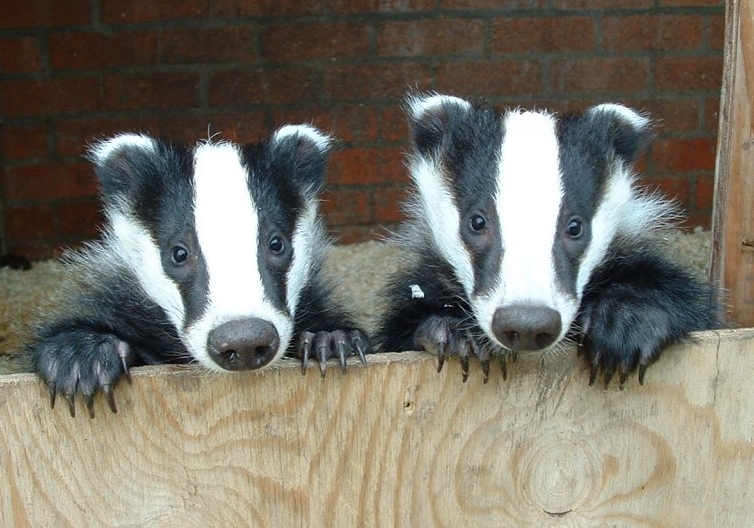
European badger(Meles meles)
Phylum —chordata
Class — mammalia
Order — carnivora
Family — mustelidae
Genus – meles
Appearance
European badgers are powerfully built animals with small heads, thick, short necks, stocky, wedge-shaped bodies and short tails. The limbs are short and massive, with naked lower surfaces on the feet. The claws are strong, elongated and have an obtuse end, which assists in digging. The claws are not retractable, and the hind claws wear with age. Their snouts, which are used for digging and probing, are muscular and flexible. The eyes are small and the ears short and tipped with white. Whiskers are present on the snout and above the eyes.Boars typically have broader heads, thicker necks and narrower tails than sows, which are sleeker, have narrower, less domed heads and fluffier tails.
Adults measure 25–30 cm (9.8–11.8 in) in shoulder height, 60–90 cm (24–35 in) in body length, 12–24 cm (4.7–9.4 in) in tail length, 7.5–13 cm (3.0–5.1 in) in hind foot length and 3.5–7 cm (1.4–2.8 in) in ear height. Males (or boars) slightly exceed females (or sows) in measurements, but can weigh considerably more. Their weights vary seasonally, growing from spring to autumn and reaching a peak just before the winter. During the summer, European badgers commonly weigh 7–13 kg (15–29 lb) and 15–17 kg (33–37 lb) in autumn.
In winter, the fur on the back and flanks is long and coarse, consisting of bristly guard hairs with a sparse, soft undercoat. The belly fur consists of short, sparse hairs, with skin being visible in the inguinal region. Guard hair length on the middle of the back is 75–80 mm (3.0–3.1 in) in winter. Prior to the winter, the throat, lower neck, chest and legs are black. The belly is of a lighter, brownish tint, while the inguinal region is brownish-grey. The general color of the back and sides is light silvery-grey, with straw-coloured highlights on the sides. The tail has long and coarse hairs, and is generally the same color as the back. Two black bands pass along the head, starting from the upper lip and passing upwards to the whole base of the ears. The bands sometimes extend along the neck and merge with the color of the upper body. A wide, white band extends from the nose tip through the forehead and crown. White markings occur on the lower part of the head, and extend backwards to a great part of the neck's length. The summer fur is much coarser, shorter and sparser, and is deeper in color, with the black tones becoming brownish, sometimes with yellowish tinges.
Habitat
They are found throughout most of Europe as well as western Asia. The area of their distribution extends southward to southeastern coast of China and northward, reaching the Russian Arctic Circle and Finland.
Behavior
The European badger is nocturnal animal. The badgers are most active at sunrise and sunset. Badgers are highly social animals, gathering in clans - family groups that may include up to 12 individuals and only one dominant breeding pair. However, during periods of food shortage, some individuals, belonging to clans, isolate themselves, leading solitary life. Throughout the territory of each clan, there are multiple setts - large, communal burrows, constructed by members of the clan. The main sett is usually situated in the center of the clan's territory and contains more adult individuals, compared to other setts.
Diet
They are omnivores, consuming food of both plant and animal origin. The usual diet of the European badger includes fruit, earth worms, insects, frogs, lizards, eggs, small mammals as well as carrion.
Reproduction
European badgers don't have certain mating system. Thus, male badgers are usually monogamous, mating once in a lifetime. However, female badgers can have polygamous behavior, mating with a number of males. Meanwhile, males do not restrict access of other males to their mates, but fiercely defend the mates from potential predators. They breed throughout the year with two peak seasons, occurring in February-May and August-October. Gestation period lasts 9-12 months, yielding 1-6 cubs with 3 on average. Young are born in a den, leaving the den at about 8-10 months old. Then, at the age of two and a half months, the cubs are weaned. Sexual maturity is reached at about 1 year old.
In captivity
The maximum life expectancy is about 14 years.
In captivity, badgers are unpretentious to the conditions of keeping and feeding.
The main requirement for the enclosure – it must be strong. The badger has powerful paws armed with claws and a weak enclosurewill be broken. If it is possible to make a dig, it will make it in any soil. Wooden decking will not prevent from digging. It is necessary to make it of concrete or metal mesh. The corners should be metal.
The minimum size of the badger enclosure is 100*60*60cm. This is actually a cell box. The badger will live even in such uncomfortable conditions. But if it is possible to make the enclosure bigger, it is better to do it. In winter, such cage should be stuffed with straw, in which it burrows and sleeps. If the enclosure is spacious, you can install a shelter (booth) where the badger will live during winter.
Hibernation in the conditions of captivity is short. During hibernation, the badger needs a constant access to food and water. He often wakes up to eat or drink.
Badgers are omnivorous. They eat whatever they have in the feeder. The food is mouse-like rodents, small birds, amphibians and reptiles, insects and their larvae, shellfish, earthworms, fruits, vegetables, nuts, acorns, berries and other plant food. You can give regular dog food to badgers. Badger eats about 0.5 kg of food per day, youngsters eat more than adults for up to a year.
 Russian
Russian
 English
English
























